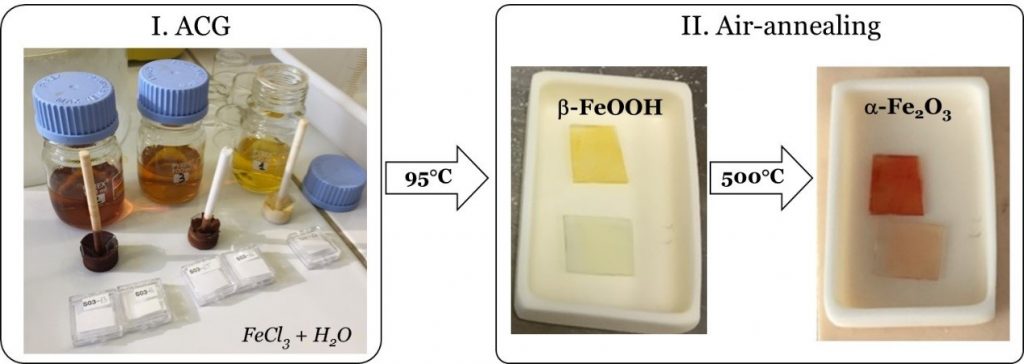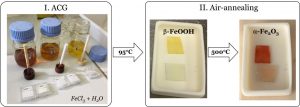The aqueous chemical growth (ACG) [1] allows growing well-organized nanostructured oxide films with thicknesses from tens to several hundreds of nanometers. For hematite deposition the substrates (e.g. FTO on glass substrates) are dipped in aqueous FeCl3 acidic solution contained in closed bottles. The hydrothermal growth activation is achieved at temperatures lower than 100°C, the substrate being covered by an iron oxy-hydroxide film, the akaganeite phase. Film morphology, thickness, crystallographic and electronic structures, chemical composition are strongly dependent of deposition parameters: solution pH, deposition time, oven temperature, substrate cleaning, etc. Phase transition to hematite (α – Fe2O3) phase is obtained by air annealing at 500 – 600°C.
[1] L. Vayssieres et al., Chem. Mater. 13, 233 (2001);
L. Vayssieres, Int. J. of Nanotechnology 1, Nos. 1/2 (2004)

Contact CEA : Dana Stanescu from SPEC/LNO.
Student internships:
Victoria Villard, internship M1: Physique et Applications, UPMC: “Synthèse des photo-anodes en solution aqueuse”, CEA – Saclay / DRF / IRAMIS / SPEC – CNRS UMR 3680 / LNO, 2017
Mekan Piriyev, M2: International Master Degree student in SERP+, Paris Saclay University: “Towards understanding the origin of the hematite photoanode optimization via Ti-doping for solar water splitting”, Synchrotron SOLEIL – CEA Saclay/DRF/IRAMIS/SPEC/LNO, 2019
Sara Mahfouf, M2: Master Inorganic Chemistry, Paris Saclay University: “Graphite electrodes patterning decorated with hematite nanorods for solar water splitting liquid microcell fabrication”, Synchrotron SOLEIL – CEA Saclay/DRF/IRAMIS/SPEC/LNO, 2020
Théo Alun, M1: Énergie renouvelables et efficacité énergétique, ESIEE Paris “Etude et optimisation des photoanodes nanostructurées d’hématite pour la production d’hydrogène par la photoélectrolyse de l’eau”, CEA – Saclay/DRF/IRAMIS/SPEC – CNRS UMR 3680/LNO, 2021
Reference:
References:
- Scanning transmission X-ray spectromicroscopy: a nanotool to probe hematite nanorods for solar water splitting, Stefan Stanescu, Dana Stanescu, Adam Hitchcock, preprint March 2023 https://chemrxiv.org/engage/chemrxiv/article-details/640de8d7b5d5dbe9e825c049
- Intrinsic photoanode band engineering: enhanced solar water splitting efficiency mediated by surface segregation in Ti-doped hematite nanorods, Stanescu S, Alun T, Dappe YJ, Ihiawakrim D, Ersen O, Stanescu D., preprint February 2023 https://chemrxiv.org/engage/chemrxiv/article-details/63ea04bdfcfb27a31fb432c8
- Characterizing surface states in hematite nanorod photoanodes, both beneficial and detrimental to solar water splitting efficiency, Dana Stanescu, Mekan Piriyev, Victoria Villard, Cristian Mocuta, Adrien Besson, Dris Ihiawakrim, Ovidiu Ersen, Jocelyne Leroy, Sorin G. Chiuzbaian, Adam P. Hitchcock, Stefan Stanescu, J. Mater. Chem. A, 2020, 8, 20513-20530 https://doi.org/10.1039/D0TA06524B; hal-02934466




